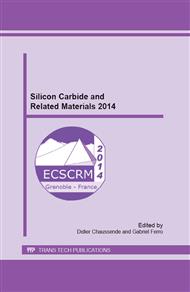p.432
p.436
p.440
p.444
p.448
p.452
p.456
p.460
p.464
Extremely Enhanced Diffusion of Nitrogen in 4H-SiC Observed in Liquid-Nitrogen Immersion Irradiation of Excimer Laser
Abstract:
We report nitrogen (N) doping of 4H-SiC by KrF excimer laser irradiation in liquid N2. In comparison to phosphorus (P) doping performed using phosphoric acid solution, the liquid-N2 immersion-laser doping can introduce N atoms deeper (~ 1 μm depth) into the 4H-SiC, which results in reduction of doped layer resistance by approximately 3 orders of magnitude. Doping is shown to proceed by the thermal diffusion of species, while loss of the host material from the surface by ablation takes place at the same time. Chemical analysis shows that high density carbon (C) vacancies are generated in the N doped region, which suggests enhanced diffusion of N assisted by the presence of C vacancies. pn junction diodes are formed by using the N doping technique. Turn-on voltage is ~ -3V, which is reasonable for a pn junction diode of 4H-SiC.
Info:
Periodical:
Pages:
448-451
Citation:
Online since:
June 2015
Authors:
Price:
Сopyright:
© 2015 Trans Tech Publications Ltd. All Rights Reserved
Share:
Citation:


